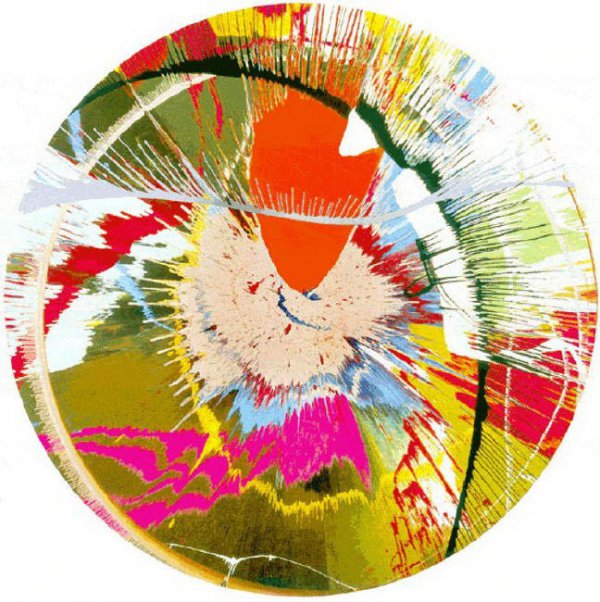
Through a systematic study of the physical world, Damien Hirst discovers what a measured input of colour combined with mathematical regularities and randomness look like. Prior to being awarded the Turner Prize in ‘95, Hirst briefly deviated from the perfected grids seen in the famous ‘Spot’ paintings and allowed colour to roam freely on the canvas; intervened only by the laws of physics and thus giving science a voice within the constraints of his purpose-built mechanical device. The result of the journey was dazzling portraits known as ‘Spin’s. Brought to life through layers of inks, Beautiful, Galactic, Exploding Screenprint marks the debut screenprint from the series.
Forget all about the prevailing scientific truth on the origin of the universe. It started with colour. Deep jungle, army and olive greens; hues of pacific blue; shimmery silver; fiery rose pink and a dark luminous orange in the centre, collectively formed a controlled explosion of colour. Added one by one by its creator onto a table-height square device with a round spinning plate in the middle, each colour experience the gravitational pull and centrifugal force determined by the speed of the spin; flattening, extending the inks into rounded shapes and semi-circle pressure waves, pushing vigorously away from the centre. This is what the beginning of time and colour look like.
Hirst’s experimentation with spin-painting started in ’92 in his South London studio, alongside fellow artist Angus Fairhurst. Both, graduates of the seminal class of ’89 from Goldsmith College of Art, they became trailblazers – amongst other alumni – for their innovative works and persistence to bypass the gatekeepers of the traditional art world; trying to reach out directly to collectors and the media through self-orchestrated events. It was during one such happening, ‘A Fete Worse than Death’, that the concept of the ‘Spin’ painting was introduced to the wondering public strolling the high-street of Shoreditch in East London. Dressed up as clowns, Hirst and Fairhurst, invited passers-by to pick squeeze-bottles containing different colour paint, and add it to a small spinning piece of paper. A collaborative artwork which once completed was signed by the artists and handed to the willing participant in exchange for £1.
The turning point for the ‘Spin’ came in 1994. Living in Berlin at the time, Hirst had a mechanical device created where he easily could spin a canvas, trying out different methods and experimenting with colour combinations. How different hues are perceived by the viewer and the affect adjacent colour have when placed side-by-side, also known as simultaneous contrast, was nothing new to the artist. Although Hirst was never a colour theorist – and more of a “mood-ist”, where colour rather is a catalyst for different feelings, such as love, happiness, envy or fear – his first ‘Spot’-paintings were indeed about portraying hues in their purest form; perfectly presented in circular spots, equally distanced on a white backdrop to minimise interference. In the ‘Spin’ paintings – on the contrary – the blending of colour was inevitable.
Debuting at Bruno Brunett Fine Art in Berlin the same year, the exhibited ‘Spin’s may at first have seemed as a shift in the artist’s practice and taking a leap from the minimalist ‘Spot’ paintings to an outburst of intermingled paint, reminiscent of the works created by the abstract expressionists in the sixties. However, considering himself more of a conceptualist – where the idea behind the works takes precedence over the visual presentation – the ‘Spin’s were a progression of Hirst’s theme of infinite abundance. An input controlled by the artist and mediated by the mechanical device, the outcome would always be guided by an element of chance and leading to a presentation of form, and a combination of colour which is endless. Hirst might have spun the plate and added the colour, but ultimately it was the laws of physics shaping each ‘Spin’, making them ‘beautiful’ on their own merit.
Ten years into his practice, Hirst had created some of the most important concepts that would define the works of his early career; earning him the prestigious Turner Prize in 1995. While the ‘Beautiful spin’ paintings can seem to live a more quiet existence amongst sharks and cows in formaldehyde, butterfly paintings and the ‘Pharmaceutical’ series, the ‘Spin’’s elaborate on the earliest, more abstract, ‘Spot’ paintings from ’86. In that context the ‘Spin’s establish themselves as a series of substance in his practice.
On the thirtieth anniversary of inviting the strollers in East London to spin their own painting, Hirst revisited the ‘Spin’. This time replacing a manual device with an app built on machine-learning, assisting the online public to pick their colour of preference and generate a personal spin. All left to Hirst was to digitally print and sign them.
Courtesy of Eyestorm, UK.
